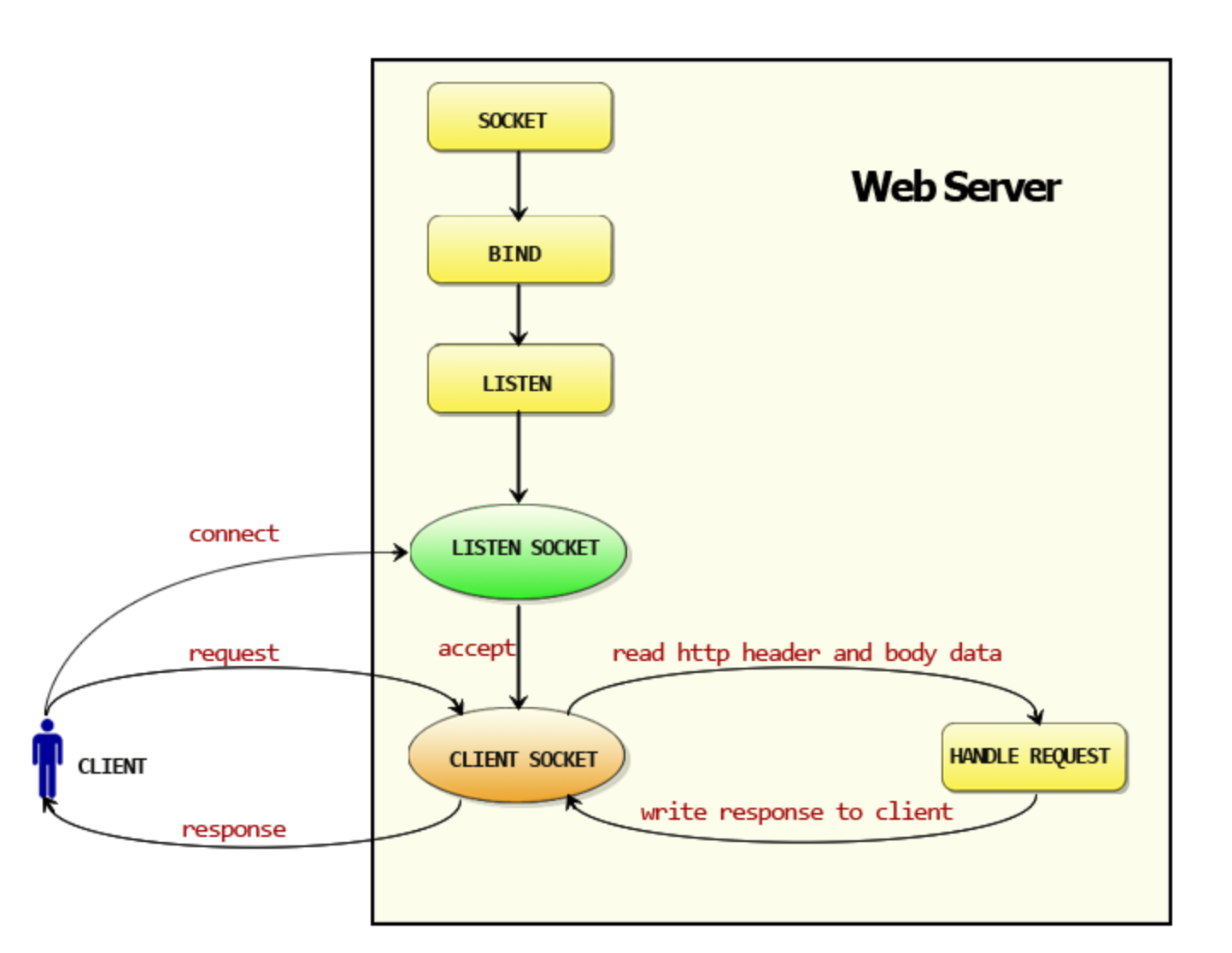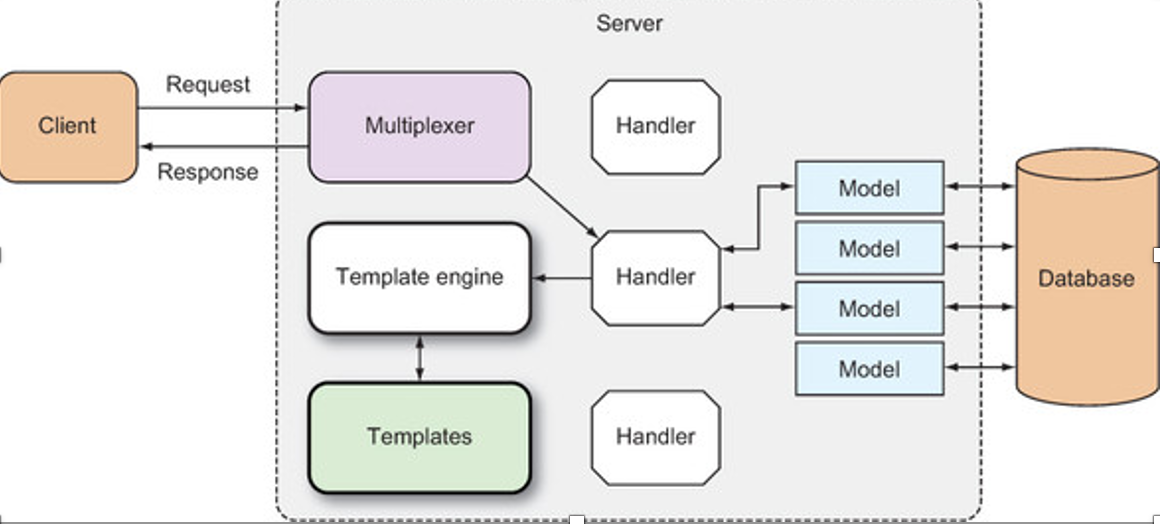Go Web基础
web 概念
Request
include post , get , cookie, url
Response
Conn
用户的每次请求链接
Handler
处理请求和生成返回信息的处理逻辑
Http 包执行流程

- 创建 Listen Socket 监听窗口
- Listen Socket 接收客户端请求——>client Socket
- Client socket 读取 HTTP请求的协议头 交给对象的 handler 处理 再通过 client socket 写给客户端
监听端口
ListenAndServe
初始化 serve 对象,调用net.Listen("tcp",addr)底层使用 tcp 协议搭建服务来监听端口
接收客户端请求
-
调用
srv.Serve(net.Listener)函数 -
每次请求创建 Conn
分配 Handler
- conn 解析 request
c.readRequest()获取 handler 即为调用 ListenAndServe 的第二个参数- 为空 nil 则默认
handler=DefaultServeMax为路由器 匹配 url 跳转到对应的 handle 函数 - 路由请求规则
“/”:- 跳转到
http.HandleFunc("/",selfFunc)中的自定义函数 - DefaultServeMux 调用 ServeHTTP 方法 内部及调用 selfFunc
- 跳转到
- 为空 nil 则默认
实战
创建 web server
使用 http.ListenAndServer()
-
第一个参数网络地址
- “” 则为所有网络接口的 80 端口
-
第二个参数 handler
- nil 则为 DefaultServeMux(multipledxer) 看做路由器
使用http.Server
- struct
- Addr 字段表示网络地址
- Handler 字段
- nil defaulSerMux
- ListenAndServe() 方法
// way One
http.ListenAndServe("localhost:9090",nil)
// way Two
server:=http.Server{Addr: "localhost:8080",Handler: nil}
server.ListenAndServe()
以上只能执行 http 而非 https
需要分别加上:
- http.ListenAndServeTLS()
- Server.ListenAndServeTLS()
Handler
是一个 interface 接口
-
定义了一个方法ServeHTTP()
- HTTPResponseWriter
- 指向 Request(struct)的指针
type Handler interface { ServeHTTP(ResponseWriter, *Request) }
DefaultServeMux
Multiplexer 多路复用器(可被视为路由器) 是 ServerMux 的一个指针变量
- 也是一个 Handler
- 转发调用其他 handler
- 调用 http.Handle 函数实际上调用的是 DefaultServeMux 上的 Hanler 方法
不指定 server struct 中的 handler 字段值
- 可以使用 http.Handle 将某个 Handler 附加到 DefaultServeMux
- http 包有一个 Handle 函数
- ServerMux struct 也有一个 Handle 方法
http.Handle
func Handle(pattern string, handler Handler)
-
第二个参数是 handler(注意是指针)
type Handler interface { ServeHTTP(ResponseWriter, *Request) // 实现 ServerHTTP 方法的类型均可视为 handler }
server := http.Server{
Addr: "localhost:1090",
Handler: nil, // use DefaultServeMux
}
http.Handle("/wo",&mh)
server.ListenAndServe()
http.HandleFunc
Handler函数行为与hanlder 类似 将 f 适配为 handler 使得handler 具有方法 f 类似类型转换
作用即为: Handler 函数转化为 Handler 内部还是调用 http.Handle 函数
- Handler 函数的签名与 ServeHTTP 方法的签名一样,接收:
- 一个 http.ResponseWriter
- 一个 指向 http.Request 的指针
// 第二个参数是 func 但是不要带() 带()就直接执行了
http.HandleFunc("/home",welcome)
func welcome(w http.ResponseWriter, r *http.Request) {
w.Write([]byte("Home!"))
}
HandleFunc 源码:
func HandleFunc(pattern string, handler func(ResponseWriter, *Request)) {
// 调用 DefaultServeMux 的 HandleFunc
DefaultServeMux.HandleFunc(pattern, handler)
}
// DefaultServeMux 的 HandleFunc 第二个参数是 Handler函数(不同于 http.Handle 第二个参数是 Handler)
func (mux *ServeMux) HandleFunc(pattern string, handler func(ResponseWriter, *Request)) {
if handler == nil {
panic("http: nil handler")
}
// 内部还是调用 http.Handle 函数
mux.Handle(pattern, HandlerFunc(handler))
}
内置 Handlers
NotFoundHandler
// NotFound replies to the request with an HTTP 404 not found error.
func NotFound(w ResponseWriter, r *Request) { Error(w, "404 page not found", StatusNotFound) }
// NotFoundHandler returns a simple request handler
// that replies to each request with a ``404 page not found'' reply.
func NotFoundHandler() Handler { return HandlerFunc(NotFound) }
给每个请求的响应均为404
RedirectHandler
// Redirect to a fixed URL
type redirectHandler struct {
url string
code int
}
// The provided code should be in the 3xx range and is usually
// StatusMovedPermanently, StatusFound or StatusSeeOther.
func RedirectHandler(url string, code int) Handler {
return &redirectHandler{url, code}
}
将每个请求使用给定的状态码code——>指定的 url 跳转到提供的第一个参数
StripPrefix
func StripPrefix(prefix string, h Handler) Handler
从请求的 URL去掉指定的前缀prefix 再调用第二个参数 handler h
- 请求的 URL 与前缀 prefix 不符合 404
- h handler 将会在 请求 url 被去除 prefix 后调用 用于接收请求
TimeoutHandler
func TimeoutHandler(h Handler, dt time.Duration, msg string) Handler
- time.Duration 表示一段时间 alias int64 的别名
- 返回 handler 在指定时间 dt duration 内运行传入的 h
- h 将要被修饰的 handler
- msg 超时则返回 msg 信息表示响应时间过长
- dt 处理 h 的允许时间
FileServer
func FileServer(root FileSystem) Handler
返回 handler 基于 root 文件系统来响应请求 root 是字符串作为根目录
// filestystem 可以自定义 通常委托给
type FileSystem interface {
Open(name string) (File, error)
}
eg 使用内置 filehandler 实现 handleFunc
http.HandleFunc("/",func(w http.ResponseWriter, r *http.Request) {
http.ServeFile(w,r,"wwwroot"+r.URL.Path)
})
http.ListenAndServe(":9090",nil)
http.ListenAndServe("8080",http.FileServer(http.Dir("wwwwroot")))
请求 Request
HTTP 请求
Request
URL
请求信息的第一行里面的信息
指向 url>URL类型的指针 url>URL 是一个 struct
scheme://[userinfo@]host/path[?query][#fragment]通用格式
Query
- 查询字符串
Header
map[string]/[]string类型
设置 key 时候创建空的[]string 作为 value 第一个元素就是新的 header 值
key 添加元素执行 append 操作
Body
io.ReadCloser 接口
-
reader 接口
- []byte 返回 byte 的数量 可选的错误
-
closer 接口
- 返回可选的错误
UpLoad
Form 表单
表单发送请求
-
html 表单里面的数据以 name-value 对的形式 通过 method 规定post/get请求发送出去
-
数据内容存储在 POST 请求的 Body里面
-
name-value 对的格式 通过表单的
Content Type指定enctype属性 -
entry 属性默认值
application/x-www-form-urlcoded -
enrty 属性设置为
multipart/form-data(大量数据、上传文件)- 每个 name-value 对转换为 MIME消息 每部分各自有 Content Type 和 Content Disposition
-
-
method 属性设置 POST 和 GET
- GET 请求没有 Body 数据通过 URL 编码的 name-value 对发送
Form 字段
-
Request 上的函数允许我们从 URL 或/和 Body 中提取数据,通过这些字段:
- Form 是 url.Values 类型——>type Values map[string][]string 类型
- PostForm
- MultipartForm
-
Form 里面的数据是 key-value 对
- 每个 key 对应一个切片 可以有多个值
-
通常的做法是:
- 调用 ParseForm 或 ParseMultipartForm 来解析 Request
- 相应的访问 Form、PostForm 或 MultipartForm 字段
-
func main() { server:=http.Server { Addr : "localhost:8080", } http.HandleFunc("/process", func(w http.ResponseWriter,r *http.Request){ r.ParseForm() // 解析 request fmt.Fprintln(w,r.Form) }) server.ListenAndServe() } // index.html 输出 是一个 map[string][]string // map[first_name:[wo] last_name:[456] uploaded:[Go Web.md]]
PostForm 字段
只读取表单的 key-value 对 不需读取 url 的 kv 对 使用 PostForm 字段
当 url 和 form 中均有 key对应的 Value 时候 Form 字段显示所有的 values 表单在前 url 在后
map[first_name:[D] firtst_name:[Nick] last_name:[as]] // D 为表单 Nick 为 url
- 只支持
"application/x-www-form-urlencoded"
fmt.Fprintln(w,r.PostForm) // 使用 PostForm字段
// map[first_name:[qw] last_name:[q]] 只显示表单输入的 key对应的 values
MultipartForm 字段
- 首先调用
ParseMultipartForm方法- 该方法会在必要时调用
ParseForm方法- 参数是需要读取数据的长度 字节数
- MultipartForm 只包含表单的 key-value 对
- 返回类型是一个 struct 而不是 map。这个 struct 里有两个 map:
- key 是 string,value 是 []string
- 空的(key 是 string,value 是文件)
- 该方法会在必要时调用
func main() {
server:=http.Server {
Addr : "localhost:8080",
}
http.HandleFunc("/process", func(w http.ResponseWriter,r *http.Request){
r.ParseMultipartForm(1024) // 解析 request 使用 ParseMultipartForm 解析 需要传入长度(字节数)
fmt.Fprintln(w,r.MultipartForm)
})
server.ListenAndServe()
}
// index 输出 struct 两个 map 第一个有数据第二个是空的
&{map[first_name:[12] last_name:[12]] map[]}
FormValue&PostFormValue 字段
FormValue 方法会返回 Form 字段中指定 key 对应的第一个 value
- 无需调用 ParseForm 或 ParseMultipartForm
PostFormValue 方法只能读取 PostForm
- FormValue 和 PostFormValue 都会调用 ParseMultipartForm 方法
- 表单的
enctype设为 multipart/form-data,无法通过 FormValue 获得想要的值。
文件 Files
-
调用
ParseMultipartForm方法 -
从
File字段获得 FileHeader 调用 Open 方法获得文件 -
使用
ioutil.ReadAll函数将文件内容读取到 []byte中func process(w http.ResponseWriter, r *http.Request) { r.ParseMultipartForm(1024) // 最大传递字节 fileHead := r.MultipartForm.File["uploaded"][0] // 读取指定 body 内容 file, err := fileHead.Open() if err == nil { data, err := ioutil.ReadAll(file) if err == nil { fmt.Fprintln(w, string(data)) } } } func main() { server := http.Server{ Addr: "localhost:8080", } http.HandleFunc("/process", process) server.ListenAndServe() }
FormFile
- 返回对应 Key的第一个文件
- 返回指定 Key 的第一个 Value
POST Json
MultipartReader
func (r *Request) MultipartReader() (*multipart.Reader, error)
type ResponseWriter interface { Header() Header Write([]byte) (int, error) WriteHeader(statusCode int)}// 是一个接口 response 实现了其内部的所有函数 所以 ResponseWriter 可视为 response 的指针
ResponseWrite
内置 Response
- NotFound 函数,包装一个 404 状态码和一个额外的信息
- ServeFile 函数,从文件系统提供文件,返回给请求者
- ServeContent 函数,它可以把实现了 io.ReadSeeker 接口的任何东西里面的内容返回给请求者
- 还可以处理 Range 请求(范围请求),如果只请求了资源的一部分内容,那么 ServeContent 就可以如此响应。而 ServeFile 或 io.Copy 则不行。
- Redirect 函数,告诉客户端重定向到另一个 URL
func process(w http.ResponseWriter, r *http.Request) { r.ParseMultipartForm(1024) // 最大传递字节 fileHead := r.MultipartForm.File["uploaded"][0] // 读取指定 body 内容 file, err := fileHead.Open() if err == nil { data, err := ioutil.ReadAll(file) if err == nil { fmt.Fprintln(w, string(data)) } }}func writeExample(w http.ResponseWriter, r *http.Request) { str := `<html><head><title>Go Web</title></head><body><h1>Hello World</h1></body></html>` w.Write([]byte(str))}func writeHeaderExampl(w http.ResponseWriter, r *http.Request) { w.WriteHeader(501) fmt.Fprintln(w, "No such service, try next door")}func main() { server := http.Server{ Addr: "localhost:8080", } http.HandleFunc("/write", writeHeaderExampl) http.HandleFunc("/redirect", headerEXample) http.HandleFunc("/json", jsonExample) server.ListenAndServe()}func headerEXample(w http.ResponseWriter, r *http.Request) { w.Header().Set("Location", "http://google.com") w.WriteHeader(302)}type Post struct { User string Threads []string}func jsonExample(w http.ResponseWriter, r *http.Request) { w.Header().Set("Content-Type", "application/json") post := &Post{ User : "wlzhou", Threads: []string {"first","second","third"}, } json,_:=json.Marshal(post) w.Write(json)}
模板
Web 模板即为 HTML 页面(预先设置好的)
text/template html/template模板库
模板引擎
合并模板和上下文数据产生 HTML
- 生成 HTML 写入
ResponseWriter再加入 HTTP响应返回给客户端 
ParseFiles
- 解析模板文件 创建解析好的模板 struct
- 是 template struct 上的 ParseFiles 上的方法调用
创建新的模板 名称为文件名
t, _ := template.ParseFiles("tmpl.html")
ParseGlob
-
模式匹配 根目录下匹配
t, _ := template.ParseGlob("*.html")
Parse
- 上述两个函数均会调用
Action
模板中嵌入的命令 两组花括号之间{{}}
条件 迭代 设置 包含 定义
参数、管道、变量
参数:
- 模板中的值
- bool 整数 string struct key 变量 方法
管道:
Unix 管道类似
- 把参数输出发送到下一个参数
- |隔开
函数
内置函数有:
define template block html js urlquery
index print len with
自定义函数:
template.Funcs(funcMap FuncMap) *Templatetype FuncMap map[string]interface{}
模板组合
路由
Controller
- Main() 设置类工作
- Controller:
- 静态资源
- 不同的请求发送给不同的 controller 处理
路由参数
-
静态路由:
- 一个路径对应一个页面
- /home /index
- 一个路径对应一个页面
-
带参路由:
- 依据路由参数 创建出一族不同的页面
- /companies/123
- /companies/homeAbout
- 依据路由参数 创建出一族不同的页面